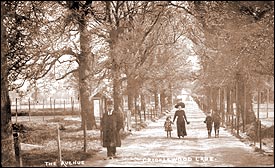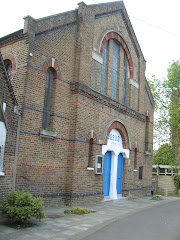Our current church website includes the following info
Beginnings
Childs Hill was once a quiet Middlesex village full of laundries (Constable painted it when he was living in nearby Hampstead). Things began to change in the 1850s after the railway came to Cricklewood. As Childs Hill and the surrounding area began to grow it also became pretty "rough".
One day, in 1863, Devonian William Rickard wandered over to the village from Hampstead, where he was assisting the minister of the Baptist Church in Heath Street. Seeing the great need he was soon, under God, able to begin regular meetings in one of the local laundries.
The present building was erected in 1870. The Granville Hall next door was added shortly after to accommodate a day school.
Early Days
In 1877 the first members covenanted together to form a local Baptist church, most having been in membership at Heath Street until this time. The church was founded on a decidedly Evangelical and Protestant basis. The great C H Spurgeon preached here on at least one occasion - as did students from his Pastors College. Mr Rickard was a pillar of the community and a faithful pastor until 1893, when he retired from the pastorate with ill health
He was followed by J Sylvester Poulton, a graduate of the Pastors College and an admirer of Spurgeon. He was here for 35 years and during his time the congregation seems to have continued to grow. Although there do not seem to have been any obvious concessions to liberalism there seems to have been some drift from preaching the good old fashioned gospel of Mr Rickard's time.
Between the Wars
From 1929 until 1954 the minister was E K Alexander. A native of Monmouthshire (now Gwent) in South Wales, Mr Alexander and his family had been missionaries in the Congo (now Zaïre) for 10 years but had been forced to return home due to ill health
During his time there was a slow but steady decline in numbers - as was the case in most churches in England at the time. There was also an increasing pre-occupation with the social side of church life rather than the gospel itself.
Since the 1950s
Since 1954 there have been five pastors (including the present one): all young men, fresh from college, evangelical in their convictions and preaching. Four of these served between 4 and 7 years. The present minister came in 1983.
Over these nearly 50 years the church has increasingly moved to a separatist position (we left the Baptist Union in 1984) and, though not uniformly, to a Reformed Baptist position as held by Spurgeon and others before and after him.
Though still small in numbers, things are presently more encouraging than they have been for a long time and we look to the Lord for increased blessing in the years to come.
Recent Events
The present pastor is Gary Brady who came to the church in 1983 after studying nearby in Finchley at the London Theological Seminary. He originally came from Cwmbran in South Wales. Before studying for the ministry he obtained an English Literature degree from the University of Wales in Aberystwyth. He later trained as a teacher in Cardiff University. In 2006, he obtained a Westminster Theological Seminary ThM through the
John Owen Centre, Finchley.
He was married in 1988 to Eleri, from Aberystwyth. They have five sons. One is married and a university student, two others are in university and two are in Hampstead School. Eleri and the boys are bilingual.
Gary is chairman of the Evangelical Library and serves as a trustee of the Grace Magazine Trust. He is also on the board of the London Theological Seminary. He has written two commentaries in the Welwyn Commentary Series on Proverbs and Song of Songs and a book on
What the Bible says about being born again as well as two other books.
In July 2001, we were pleased to appoint our first assistant pastor, Robin Asgher. Robin is from Pakistan and studied at LTS. He has now moved on to a church planting work in Cranford, West London.
From August 2002-September 2003 our assistant pastor was Mark Raines. Mark was also previously at LTS and is now an assistant pastor in the USA.
From September 2006-July 2007 our assistant pastor was Ian Middlemist. Ian is yet another LTS man. Before that he spent two years with Birmingham City Mission. He is now a pastor in Haverford West in Wales.
After along period when it has not been possible to employ an assistants we now not only mentor students from the LTS on a regular basis but again have a former LTS man as assistant, namely Andrew Lolley from Leeds.
































